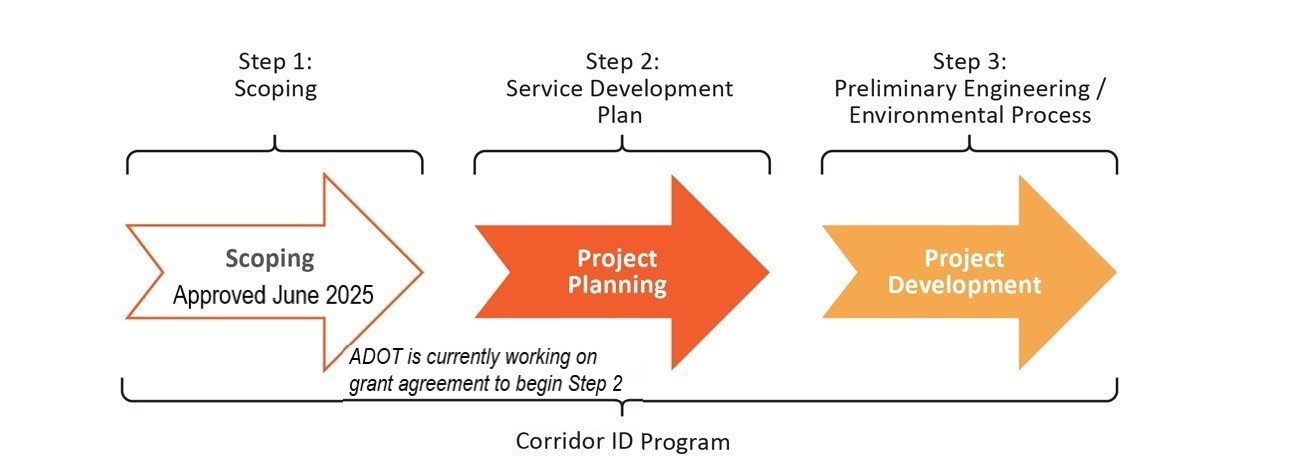Phoenix-Tucson Intercity Passenger Rail Corridor Study
Phoenix-Tucson Intercity Passenger Rail Corridor Study
Contents
Overview
The Arizona Department of Transportation (ADOT) is conducting the Phoenix to Tucson Intercity Passenger Rail Corridor Study through a Corridor Identification and Development Program (CIDP) grant from the Federal Railroad Administration (FRA).
The study will prepare a Service Development Plan (Plan) for proposed passenger rail service along a 158-mile corridor between the greater Phoenix and Tucson regions. The route was selected through a FRA Tier 1 Environmental Impact Statement (EIS) and Record of Decision completed for the corridor in 2016. To view past documents and the results of the Tier 1 EIS, click here.
This study will build upon the previous EIS by conducting a detailed analysis of engineering, environmental factors and operations. It will also include stakeholder engagement and public outreach to determine the necessary service requirements and financial planning considerations for advancing intercity passenger rail between Arizona's two largest metropolitan areas of Phoenix and Tucson.
This project represents an alternative mode of transportation connecting the state’s two largest metropolitan areas to complement vehicular travel on I-10, the one interstate highway linking the two regions.
Future Funding
It is important to note a Phoenix to Tucson passenger rail corridor is not currently funded for implementation. However, this study will provide an important step in determining stakeholder support, service coordination with Union Pacific Railroad and Amtrak, infrastructure needs and project costs to implement this service.
Additional Service Study
In addition, Amtrak is conducting a study through an FRA CIDP grant to evaluate the proposed Daily Sunset Limited service between Los Angeles and New Orleans, which includes plans to reestablish Sunset Limited service to Phoenix. The proposed new route overlaps with the Phoenix to Tucson Passenger Rail corridor proposing to use the same Union Pacific Railroad tracks - however, these two services are intended to be complementary and ADOT will coordinate this study with Amtrak officials.
Purpose of Current Study
The Phoenix-Tucson Intercity Passenger Rail Corridor Study will analyze impacts and requirements necessary to complete a Service Development Plan for the project. This study will:
- Assess the market conditions and ridership potential of the corridor
- Conduct technical analysis of:
- Capital and service requirements for passenger rail service
- Preliminary engineering and costs for capital improvements, such as stations, parking lots and trains
- Station locations
- Service scenarios based on ridership potential
- Environmental and transportation impacts
- Implementation Plan describing the phases for project implementation
ADOT will conduct extensive public and key stakeholder outreach as part of the project development process to assess interest, define station locations and other project elements, determine the entity that will manage the service and identify funding strategies.
What is Intercity Passenger Rail?
An intercity passenger rail system is designed to provide service between cities, with limited stops to serve major destinations, such as airports, and population centers. Intercity passenger rail operates typically at speeds up to 79 MPH on railroad tracks separated from vehicle traffic to provide fast, dependable travel times. An example is the Rail Runner service between Albuquerque and Santa Fe, which takes approximately 90 minutes and provides multiple daily trips, with more frequent weekday service.
Project Process
- Step 1 (Scoping): In June 2025, FRA approved ADOT's Step 1 work plan that includes the scope, schedule and budget for preparing a Service Development Plan for the Phoenix to Tucson Intercity Passenger Rail Corridor. Work on the Service Development Plan can begin after approval of a federal grant, which is expected in fall 2025.
- Step 2 (Project Planning): ADOT will prepare a Service Development Plan, in coordination with FRA, and with stakeholder and public engagement. The plan is expected to take approximately two to three years to develop, pending FRA review and approval.
- Step 3 (Project Development): Based on FRA’s approval to proceed to Step 3, ADOT will conduct preliminary engineering and an environmental analysis on the proposed capital improvement project for the Phoenix to Tucson intercity passenger rail corridor.
Passenger Rail Corridor ID Program Development Stages

Public Engagement Materials
Stay Informed
Please subscribe to receive project updates by email.
For questions or comments contact us in any of the following ways:
- Phone: Call Nancy Becerra 623.695.7411
- Email: [email protected]
- Mail: Phoenix-Tucson Intercity Passenger Rail, 1655 W Jackson, Room 179, MD 126F, Phoenix, AZ 85007

